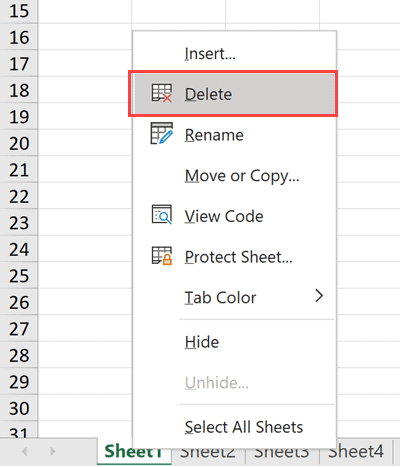Delete All Hidden Excel Sheets Instantly: Here's How

Excel, one of the most widely used tools for data management, often contains hidden worksheets that can clutter your workspace or protect sensitive data from view. Knowing how to quickly remove these hidden sheets can be essential for streamlining your workflow, freeing up resources, or preparing files for sharing. In this comprehensive guide, we'll explore various methods to delete all hidden Excel sheets instantly. Whether you're using Microsoft Excel on Windows or Mac, or employing other spreadsheet software, we've got you covered with step-by-step instructions and essential tips.
Understanding Hidden Excel Sheets

Before we dive into the methods of deleting hidden sheets, it's crucial to understand what they are:
- Visibility: Hidden sheets are not visible when you navigate through the workbook, but they can still be accessed or unhidden with the right commands.
- Purpose: They're often used to contain data or macros that support the workbook's functionality without cluttering the user's interface.
- Security: Sometimes, sheets are hidden to prevent accidental changes or to hide sensitive information.
Method 1: Manual Deletion via VBA in Excel

Here's how to use VBA (Visual Basic for Applications) to delete all hidden sheets in an Excel workbook:
- Open your Excel workbook.
- Press Alt + F11 to open the VBA Editor.
- In the VBA Editor, click Insert > Module to add a new module.
- Paste the following VBA code into the module:
Sub DeleteHiddenSheets()
Dim ws As Worksheet
Application.DisplayAlerts = False
For Each ws In ThisWorkbook.Worksheets
If ws.Visible = xlSheetHidden Then
ws.Delete
End If
Next ws
Application.DisplayAlerts = True
End Sub
- Run the macro by placing the cursor within the Sub and pressing F5.
- All hidden sheets will be deleted. Remember, this action is permanent unless you've saved a backup.
🔍 Note: Using VBA can be risky, so always have a backup before running macros.
Method 2: Using Excel Options

If you're not comfortable with VBA, there's a simpler, though less efficient, way:
- Open your workbook.
- Go to File > Options > Advanced.
- Under Display options for this workbook, uncheck Show sheet tabs. This will show all sheets, including hidden ones.
- Click OK.
- Select each hidden sheet by right-clicking the tab of any visible sheet, selecting Unhide, then deleting the sheet from there.
- Re-enable sheet tabs in the Excel Options to return to normal view.
👀 Note: This method requires manual selection and deletion, which might be time-consuming for workbooks with numerous hidden sheets.
Method 3: Batch Delete with Add-ins

There are Excel add-ins available that can automate the process:
- Search for add-ins like ASAP Utilities, Excel-Tool, or OtherSheetManager, which provide functionality to delete all hidden sheets at once.
- Install the add-in and use its features according to the tool's documentation.
| Add-In | Function | User Experience |
|---|---|---|
| ASAP Utilities | Automated hidden sheet deletion | User-friendly with step-by-step instructions |
| Excel-Tool | Batch sheet management | Requires some setup but offers advanced functionality |
| OtherSheetManager | Quick hidden sheet deletion | Simple interface, less advanced options |

Method 4: PowerShell for Windows Users

If you're comfortable with command line interfaces, PowerShell can be used to automate the process:
- Open PowerShell with administrative privileges.
- Navigate to the folder containing your Excel file using the cd command.
- Use a PowerShell script to automate Excel to delete hidden sheets:
$xl = New-Object -ComObject Excel.Application
$xl.Visible = $false
$wb = $xl.Workbooks.Open("path\to\your\file.xlsx")
$sheets = $wb.Worksheets
foreach ($sheet in $sheets) {
if ($sheet.Visible -eq -1) {
$sheet.Delete()
}
}
$wb.Save()
$wb.Close()
$xl.Quit()
This script opens the workbook, hides Excel, and deletes all hidden sheets. Make sure to replace "path\to\your\file.xlsx" with the actual path to your file.
🚀 Note: PowerShell requires some knowledge to use effectively but provides powerful automation capabilities.
Method 5: Use Third-Party Software

If you don't want to write code, several third-party software solutions can manage Excel files:
- Excel Compare: Can automate sheet deletion and management across multiple workbooks.
- Advanced Excel Tools: Often include features for batch operations on Excel sheets, including deletion of hidden ones.
Summary

From the simplicity of manual deletion through Excel's interface to the efficiency of scripting with VBA, PowerShell, or using add-ins, there are multiple avenues to delete hidden Excel sheets instantly. Understanding the tools at your disposal and the context in which you work can guide you to the most suitable method for your needs. Here are the key takeaways:
- Excel VBA scripts provide an automated solution for users familiar with coding.
- Excel Options allow manual deletion, though this can be time-consuming.
- Add-ins and third-party software offer user-friendly automated options for those less comfortable with code.
- PowerShell scripting provides a powerful batch solution for advanced users.
Whether you're looking to tidy up your Excel workbook for better performance or ensuring sensitive data isn't accidentally shared, these methods will equip you with the knowledge to manage hidden sheets effectively.
Why should I delete hidden Excel sheets?

+
Hidden sheets can clutter your workbook, potentially slow down performance, and they might contain sensitive data you don’t want to share when distributing the file.
Can I undo the deletion of hidden sheets?

+
No, deletion of sheets in Excel is a permanent action unless you have saved a backup of the workbook.
What precautions should I take before using these methods?

+
Always ensure you have a backup of your Excel workbook before running macros or scripts that modify or delete sheets. Additionally, verify the sheets you’re deleting are indeed redundant or unimportant to your workflow.
Can I use these methods for Excel Online?

+
Excel Online has limited VBA support and script execution capabilities, making the VBA and PowerShell methods less viable. However, you can manually unhide and delete sheets through Excel’s interface or use add-ins that support Excel Online.